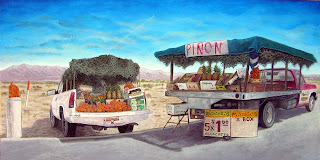A vast sky covers a magnificent landscape marked by awe-inspiring sculptures left by wind and water, and remote rocks where ancient peoples left petroglyphs. The very idea of a fence or wall dividing the world from itself is absurd. Against Nature’s dignity.
Those walls are species-threatening for animals who assumed they had some right to live as they always have, and tragic for peoples who have lived centuries in this land, where families gathered freely, trading and talking, making music and love, honoring ancestors and welcoming visitors. Now walls and armed men prevent families from visiting Abuelita.
Entering the Las Cruces Museum of Art for “Icons and Symbols of the Borderland,” I see first a dry, cracked riverbed littered with bullet casings, where an agave is giving birth to a wailing infant, while dark clouds in the background send down lightning. It’s not a subtle painting, but I couldn’t cram into words what it says to me. Maybe, “Our borderland is a wonderfully eclectic mix of harsh beauty and startling magic, as vivid as some dreams – a beautiful landscape full of fine people suffering too much.” The painting is Antonio Castro’s Renacimiento. He suggests that the border can be a mother, repeatedly giving birth to hope, despite the violence.
In
the book on this traveling exhibit, a young girl stares through a
chain-link fence, her fingers grasping the metal. On her left hand
sits a monarch butterfly (a fellow migrant). It’s Oscar Moya’s
Añorando.
Señor Moya, I think,
you have made something magnificent! Simple, direct, and eloquent.

Añorando - Oscar Moya
Another Moya painting in the show could be from the north valley: two pickups loaded with avocados, fruits, and vegetables for sale in a dry, sun-soaked land. Again, simple, direct, eloquent. Born in Mexico City, Moya came to the U.S. at 15 with his family, working in the fields. I want to shout, “Hey, border patrol, a kid you’re herding around contemptuously will make things of unimaginable beauty!”
Castro’s
The Nutcracker portrays a formidable woman, and his Emigrante
a sturdy, determined migrant carrying a nearly empty plastic
waterbottle through the stark desert. In Diana Molina’s close-up
of a Tarahumaran runner’s foot in a huarache sandal, sand and skin
are indistinguishable. Miguel Valenzuela’s work stresses “what
we don’t talk about, the migration of our culture and Americana to
elsewhere.” (All three are or were long-time El Paso residents. Molina lives in southern Dona Ana County, and Castro has moved to the Tucson area.)
Emigrante - Antonio Castro
Artists fashion art from what they see and feel. There’s much to see and feel in our Borderland, especially if you are of our Borderland, your people artificially divided, your humanity questioned by the eyes and actions of officials. Much to love, to learn, to resent; much to demand must change. And a rich silence vast as our sky, if you truly listen.
The show goes far beyond “immigration issues.” Its four themes are “Environment,” “La Frontera,” “Comida y Bebida,” and “The Sacred and the Profane.” The works don’t shy from our land’s often oppressive, inhospitable nature, but mix in human struggles and astonishing scenery. The Virgin of Guadalupe is a frequent presence, as are the monarchs. And guns. There’s a lot here to think about, some of it edgy, humorous, or both. There’s also much simply to savor, with thinking optional.
I highly recommend this exhibit. Curator Molina has assembled an evocative and relevant collection which will linger in our Museum, at 491North Main Street, until October 15, and in our hearts and minds longer.
– 30 --
[The above column appeared this morning, Sunday, 14 August 2022, in the Las Cruces Sun-News, as well as on the on the newspaper's website and KRWG's website. A related radio commentary will air during the week on KRWG (90.7 FM) and on KTAL (101.5 FM / http://www.lccommunityradio.org/) and be available on both station’s websites.]

Piedad - photo by Diana Molina
 |
| Nican Mapahua - A Castro |
 | |||
| Hombre que le Gustan las Mujeres | Cesar Martinez |
 |
| Desert Fruit Stand - Oscar Moya |

No comments:
Post a Comment